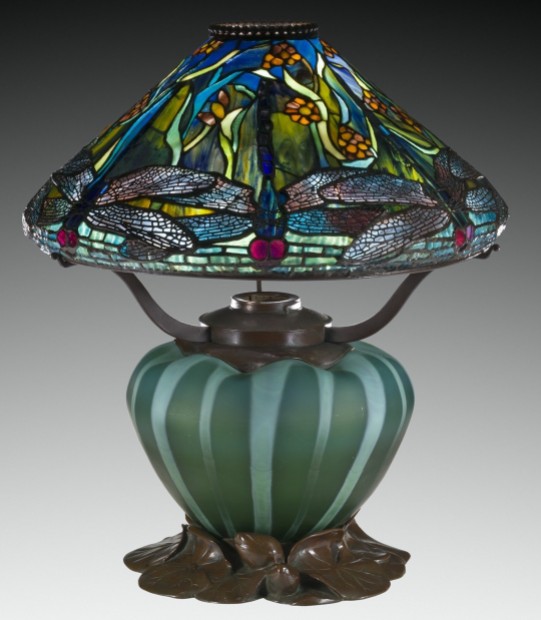
NEW YORK – Dragonflies have long been a popular symbol in art and literature signifying power, victory and change. Japanese art in particular is rife with dragonflies and is a national symbol. Also a popular motif in Art Nouveau art, dragonflies have graced any manner of antiques and artwork from paintings, furniture and silver to vases, jade carvings and lamps.
“Dragonflies first piqued the interest of 19th century decorative artists as part of the Japonisme wave,” said Ben Macklowe, owner of Macklowe Gallery in New York City. “Dragonflies were an extremely important part of Japanese culture. Akitsu is an older version of tombo, the Japanese word for dragonfly. It was named dragonfly island by Japan’s first emperor, who saw Japan’s shape as two dragonflies mating.”
Dragonflies are apex predators among insects so their agility and ferocity made them a popular motif on tsuba and having a dragonfly on your sword guard signified your fighting prowess and nationalism, explained Macklowe. Louis Comfort Tiffany and Edward C. Moore both had tsuba collections and made lamps, stained glass and fireplaces entirely made of tsuba.
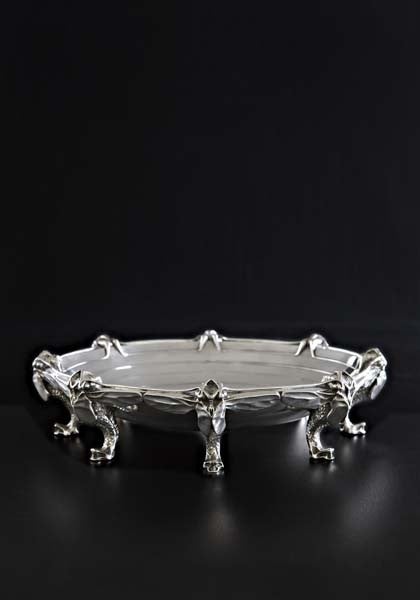
A few years earlier as Louis Pasteur was working in microbiology, hybridization of different species became a goal to work towards. “Gallé, as well as many of his avant-garde contemporaries, believed that you could hybridize dragonflies and butterflies, lions with frogs, and any other crazy combination sometime in the future,” Macklowe said. “This scientific hybridization also coincided with the fact that dragonflies were a symbol of metamorphosis. The second half of the 19th century in both Vienna and France was a period of sexual liberation. Dragonflies encapsulated the changing role of women from demure damsel to femme fatale. You can see this in Lalique’s famous ‘Dragonfly-woman” corsage ornament at the Calouste Gulbenkian. The dragonfly is a cross between harpy and dragonfly, the harpy itself being a cross between bird and woman. The woman is thus in a constant state of evolution.”
Of course, what first springs to mind when examining dragonflies in antiques are Tiffany’s iconic Dragonfly floor and table lamps. Tiffany’s lead designer, Clara Driscoll, designed the first model, “Dragonfly and Water Flowers,” which debuted in 1899 at London’s Grafton Galleries and won a bronze medal at the 1900 Paris Exposition.
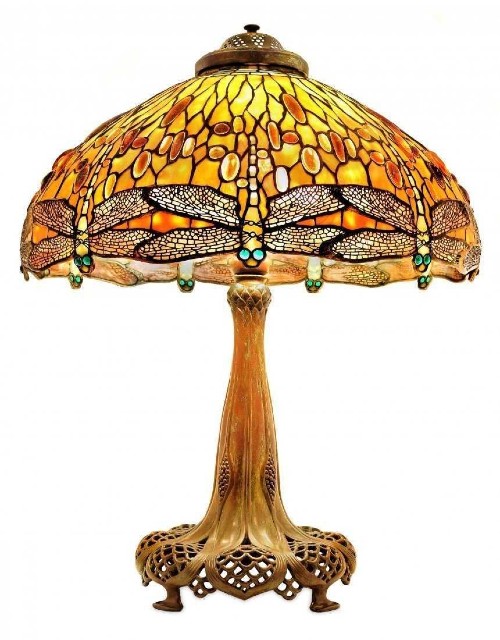
As Japan opened its country’s borders to the West, there was a cross-pollination as the Eastern aesthetic inspired the West and Western artists influenced their counterparts in the Far East.
Dragonflies were a popular motif in Ukiyo-e (woodcut) picture albums as seen in this artwork published in the Bairei Gafu by Kono Bairei. This book was one of several left to Emile Galle and his firm by Hokkai Takashima (1850-1931), a fellow botanist and member of the Ecole de Nancy in Nancy, France.
Tiffany, Gallé and Carlo Bugatti designed many works featuring dragonflies. Gallé specialized in cameo glass vases and lamps, many of which were festooned with dragonflies, but also created furniture with this style of decoration. A Libellules et Martin Pecheur display cabinet, 1903, by Emile Gallé fetched €86,000 + the buyer’s premium in November 2018 at Quittenbaum Kunstauktionen GmbH. The cabinet in carved nutwood and with marquetry features a bevy of dragonflies amid a heath landscape. This circa 1900s Gallé table goes the extra mile with its legs made in the form of dragonflies with outstretched wings. This form was of the type of furniture with dragonfly legs that Gallé introduced at the 1900 Paris Exposition, evoking both strong praise and criticism. Its admirers clearly were prescient as fine museums have since snapped up worthy examples.

“The Dragonfly model was the most popular in Louis Comfort Tiffany’s time, and it remains so today. It was among the most prolific but certainly not the most prolific of his leaded glass shades,” Macklowe said, noting that production of dragonfly lamps ceased in 1924, but the lamps continued to be sold after Tiffany’s death in January 1933.
Among artists fascinated with dragonflies was Qi Baishi (1864-1957), who has painted many paintings featuring dragonflies, some with a lotus flower (a sacred symbol in Buddhist art) and some with morning glory flowers. Asian carvings with dragonflies are also numerous such as this carved jade water dropper that brought $27,000 + the buyer’s premium at Clarke Auction Gallery in April 2019.
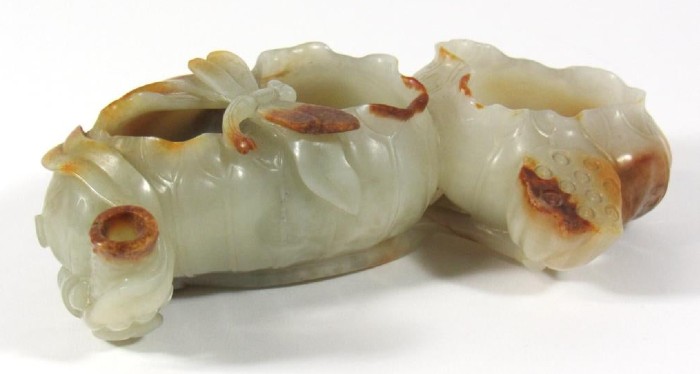
“Our contemporary master Qi Baishi did not allow the political turmoil surrounding the fall of the Qing Dynasty, the establishment of the Republic of China and the rise of the Chinese Communist Party, to affect his work or undermine his own values and ideals,” said Mary Ann Lum of Gianguan Auctions http://www.gianguanauctions.com in New York City, noting that Baishi continued to stay true to traditional cultural values. In Chinese mythology, the dragonfly represents the soul of a dragon, prosperity, strength and happiness, she said. “The dragonfly in his everyday depiction of daily life symbolizes hope for the future. They are drawn in flight, mutinously and in fine detail.”
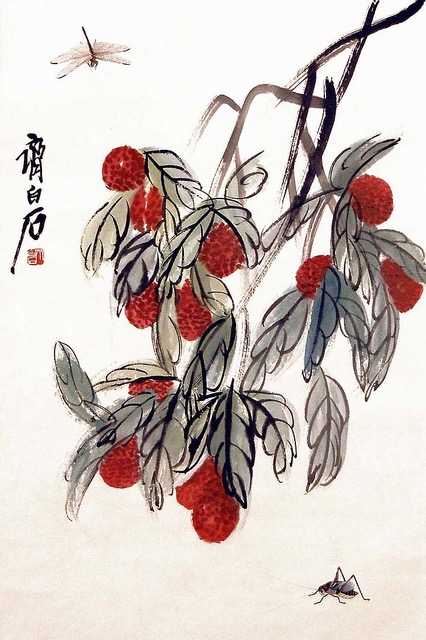
The House of Bugatti is well known for its bronzes and cars but Carlo Bugatti crafted exceptional dragonfly-themed decorative objects such as a silver footed bowl, circa 1907, that brought $95,000 + the buyer’s premium in December 2010. Bugatti’s dragonfly tea services, circa 1908, were also highly sought after. Among furniture, a vitrine with dragonfly handles, circa 1902, sold at Christie’s New York in December 2017 for $106,250 + the buyer’s premium.

Lalique also has museum-worthy items inspired by dragonflies such as this “Dragonfly woman” gold cane handle, circa 1900, that realized $50,000 + the buyer’s premium in December 2015 at Rago Arts and Auction Center. Modeled as a nude nymph in the torso with one draped wing, the figure is depicted with an agonized expression.
Subject to various different interpretations of its symbolism, dragonflies are a key motif in antiques and artwork. Their graceful and colorful appearance continues to delight.


